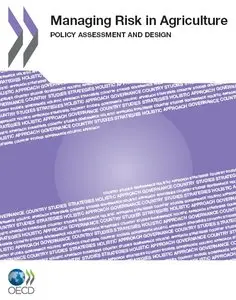Managing Risk in Agriculture : Policy Assessment and Design
OECD | 30 June 2011 | ISBN: 9789264116092 9789264116146 | 257 pages | PDF | 3 MB
OECD | 30 June 2011 | ISBN: 9789264116092 9789264116146 | 257 pages | PDF | 3 MB
This book examines the implications of risk management for policy in agriculture. Opening with a chapter on risk management principles and guidelines for policy design in agriculture, the book goes on to look at quantitative analysis of risk and then at policy in various countries.
The agricultural policy reform process in many OECD countries seeks to implement less distorting forms of support while improving farm incomes. These reforms have increased the exposure of farmers to price risks, particularly where price support has been reduced. At the same time, food security and adapting to climate change are increasingly important priorities for policy makers around the world. These and other factors indicate the growing awareness of the need for agricultural risk management.
Several countries are thus implementing programmes to manage risk. These programmes include financial contributions to risk market instruments (e.g. insurance and future contracts), payments that partly cover the producers’ risks (e.g. revenue insurance programme, counter-cyclical payments, ad hoc assistance), and, in some cases, market interventions.
The United States’ 2008 Farm Bill included a new average Crop Revenue Election (ACRE) programme; Canada’s Growing Forward policy framework has four components on business risk management; Australia is currently revising its drought policy; Mexico has expanded its programmes on price hedging in recent years, the European Union’s Health Check opened the possibility of using EU funds to support some risk management policies (crop insurance and mutual funds), and a new EU risk management toolkit is under discussion.
India and, more recently, China are implementing crop insurance programmes with government support.
Interactions between risks, strategies and government programmes need rigorous analysis, to which this publication hopes to contribute.
Table of contents
Chapter 1. Risk management principles and guidelines for policy design in agriculture
Chapter 2. A policy framework for risk management in agriculture
2.1. Applying the holistic framework
2.2. Understanding farming risks
2.3. Empowering farmers to manage normal risks
2.4. Enhancing risk markets
2.5. Steering disaster assistance.
2.6. Income support, income stabilisation and governance of risk management in agriculture
PART I. QUANTITATIVE ANALYSIS OF RISKS AND STRATEGIES
Chapter 3. Risk exposure at the farm level
3.1. Risk exposure and farm level data
3.2. Characteristics of production and price risk at the farm level
3.3. Decomposition of farm income risk
3.4. Policy implications
Chapter 4. Risk management strategies and policies at the farm
4.1. Economic analysis of risk management at the farm
4.2. Risk market instruments: Demand and the impact on farm welfare
4.3. Price intervention: Does it stabilise income?
4.4. Direct payments: What are the risk-related effects?
4.5. Policy implications
Chapter 5. Exogenous risk and price variability
5.1. Market price volatility and exogenous shocks
5.2. Methodology for studying price variability with the AGLINK-COSIMO model
5.3. Marginal contributions of exogenous shocks on crop price volatility
5.4. Total impacts of exogenous shocks on crop price volatility
5.5. Why do episodes of very low or very high volatility occur?
5.6. Conclusions
PART II. POLICY ASSESSMENT
Chapter 6. Managing droughts and bio-security in Australia
6.1. Overview of government risk management measures
6.2. Adjusting objectives and instruments in drought risk management policy
6.3. Bio-security risk management: Public-private partnership approach
6.4. Policy implications
Chapter 7. Comprehensive business risk management policies in Canada
7.1. An overview of government risk management measures
7.2. Risk layering in Canada’s policies
7.3. Information and programme targeting
7.4. Policy implications
Chapter 8. Towards ex ante policies for catastrophic risks in the Netherlands
8.1. An overview of government risk management measures
8.2. Management of pest and disease risks in the crop sector
8.3. Management of pest and disease risks in the livestock sector
8.4. Policy implications
Chapter 9. The Adverse Events Framework and collective action in New Zealand
9.1. An overview of government risk management measures
9.2. New Zealand’s On-Farm Adverse Events Recovery Framework
9.3. The role of farmer collective action in risk management
9.4. Policy implications
Chapter 10. The public-private insurance system in Spain
10.1. An overview of government risk management measures
10.2. Contribution of the Spanish insurance system to market efficiency
10.3 The hybrid insurance system as a device for catastrophic risk policy
10.4. Policy implications
with TOC BookMarkLinks



